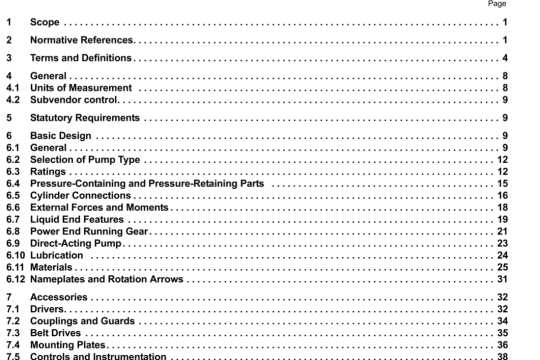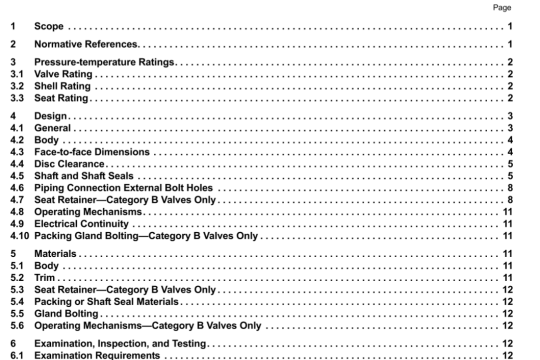API RP 578:2010 pdf download
API RP 578:2010 pdf download.Material Verification Program for New and Existing Alloy Piping Systems.
3.11
mill test report
A certified document that permits each component to be identified according to the original heat of material from
which it was produced and identifies the applicable material specification (including documentation of all test results
required by the material specification).
3.12
owne rlu se r
An owner or user of piping systems who exercises control over the operation, engineering, inspection, repair, alteration, testing, and rerating of those piping systems.
3.13
positive material identification (PMI) testing
Any physical evaluation or test of a material to confirm that the material which has been or will be placed into service is consistent with the selected or specified alloy material designated by the owner/user. These evaluations or tests may provide either qualitative or quantitative information that is sufficient to verify the nominal alloy composition.
3.14
pressure-containing components
Items that form the pressure-containing envelope of the piping system.
3.15
random
Selection process by which choices are made in an arbitrary and unbiased manner.
3.16
representative sample
One or more items selected at random from the inspection lot that are to be examined to determine acceptability of the inspection lot.
3.17
standard reference materials
Sample materials for which laboratory chemical analysis data are available and are used in demonstrating test instrument accuracy and reliability.
4 Extent of Verification
4.1 General
The owner/user should establish a written material verification program indicating the extent and type of PMI testing to be conducted during the construction of new piping systems, retroactively on existing piping systems, and during the maintenance, repair, or alteration of existing piping systems.
For higher-risk systems, the owner/user should consider the need for employing a higher percentage of examination (up to 100 %) rather than random sampling which may be more appropriate for lower-risk systems. Inadvertent material substitution problems tend to be sporadic: therefore, small sample sizes may not locate all inadvertent alloy substitutions. The owner/user should also consider the need to conduct examinations after fabrication is complete, to ensure that incorrect substitutions did not occur at the work site.
4.1.1 Alloy Substitutions in Carbon Steel Systems
When determining the need to perform material verification on carbon steel systems, the owner/user should evaluate the effect that the process stream could have on substituted alloy materials. In some cases, the substitution of hardenable alloy materials in carbon steel piping systems resulted in failure and loss of containment. Examples of such systems include wet hydrogen sulfide (H2S), hydrofluoric acid (HF), and sulfuric acid (H2S04) services.
4.2 New Construction Quality Assurance (QA) Material Verification Program
This section covers alloy piping during fabrication either in the shop or in the field prior to the items being placed into service and is restricted to the pressure-containing boundaries.
4.2.1 Roles and Responsibilities
A material verification program for piping systems may involve participation of several groups within the operating plant or the shop of a contractor, vendor, or fabricator. When establishing a material verification program, consideration should be given to the roles and responsibilities that each group has within the specific organization. These roles and responsibilities should be clearly defined and documented. Within the operating plant, this can include those groups responsible for purchasing, engineering, warehousing/receiving, operations, reliability, maintenance, and inspection.
It is the responsibility of the owner/user or designee to determine the extent of examination required and to verify that the implementation and conduct of the material verification program is properly performed in accordance with this RP. It is also the responsibility of the owner/user to verify that the alloy materials subsequently placed into service are as specified, and that the documentation of the material verification program is in accordance with this RP.
4.2.2 MaterIal Verification Test Procedure Review
When PMI testing is performed by the material supplier or third-party agency, the owner/user or designee should review and approve the adequacy of the material verification program and testing procedure of the fabricator or material supplier prior to testing.
4.2.3 Scheduling of Material Verification Testing
PMI testing should be performed at the point in time that ensures that proper alloy materials have been used in the fabrication of an identifiable assembly.
4.2.4 Mill Test Report
Mill test reports should not be considered a substitute for a PMI test. However, mill test reports are an important part of an overall material quality assurance program.
4.2.5 Components Covered in a Material Verification Program
Examples of pressure-containing components that make up fabricated piping systems that are covered by this RP include.




